Leyte Naval Battles

The waters around the Phillipines would be the site of the largest naval battle of the war, as the Japanese desperately strove to turn back the American invasion of Leyte. Their operational plan was, as usual, very complicated, involving the movement of forces scattered in bases both in Japan and Borneo. Basically, Admiral Jisaburo Ozawa's depleted Mobile Force, it's carriers practically denuded of aircraft, would come down from Japan in an attempt to draw US naval might northward, away from Leyte. Simultaneously, two battleship groups who had been training in Singapore and Borneo would cruise northward separately and attempt to reach the Leyte landing beaches through the northern (San Bernardino Strait) and southern (Surigao Strait) approaches to the island. In this way the Japanese hoped to bring into play the one largely undamaged asset still at their disposal; the formidable guns of the Navy's battleships.

(Map developed from Dull, "A Battle History of the Imperial Japanese Navy." Original map by Donald Hoegsburg)
Legend:
 = Battle
= Battle
#1 = Ambush in the Palawan Passage, October 23, 1944
#2 = Battle of Sibuyan Sea, October 24, 1944
#3 = Battle of Surigao Strait, October 24-25, 1944
#4 = Battle off Samar, October 25, 1944
#5 = Battle of Cape Engano, October 25, 1944
#6 = Battle of Ormoc Bay, November 11, 1944
Aftermath
#1. Ambush in the Palawan Passage
(October 23, 1944)
Two battleship forces, one under Admiral Takeo Kurita, the other under Admiral Shoji Nishimura, left Borneo separately on October 22nd. Kurita's force headed for the Palawan Passage, a narrow strip of dangerous, reef-infested waters. There, on the morning of October 23, they were intercepted by a pair of American submarines, Darter and Dace, who had been shadowing them through the night. Atago was attacked first (at 0524 by Darter) and received four or five hits. She sank within half an hour with heavy casualties, placing Kurita in the water. Simultaneously, Darter had attacked Takao with her stern tubes, hitting her twice at 0534, and sending her limping to Singapore, where she would sit for the rest of the war. Finally, at 0556, Dace attacked Maya, hitting her four times and causing her to explode. She sank at 0605 with heavy casualties. Admiral Kurita was fished out of the water and transferred his flag to Yamato, but it is speculated that his morale was negatively affected by the incident.
| Ambush in the Palawan Passage | Japan | Allied |
| Starting Forces |
 x2 x2
 x2 x2
 x10 x10
 x2 x2
 x15 x15
|
 x2 x2
|
| Losses |
 x2 sunk (Maya, Atago ) x2 sunk (Maya, Atago )
 x1 heavily damaged(Takao) x1 heavily damaged(Takao)
|
Big fat zero, although Darter ran aground and had to be abandoned shortly afterwards.
|
Return to Top
#2. Battle of the Sibuyan Sea
(October 24, 1944)
Once Kurita's force made it into the Sibuyan Sea, west of Leyte, the fun really began. American carrier aircraft pounded the group of warships most of the day on the 24th. What little Japanese air cover there was over the squadron was driven off almost instantaneously by the superior American airpower. Most of their attacks were directed at the hapless Musashi, which succumbed to her wounds late in the afternoon after absorbing a staggering amount of punishment (twenty torpedoes, seventeen bombs, and eighteen near misses). Several other vessels received damage as well. Kurita briefly turned his force around to the west to get out of American air range, but then returned to an eastward heading. As luck would have it, the American fast battleship force that might have met him in the San Bernardino Strait that night had been moved northward with Halsey's carrier forces as he sought to attack Ozawa's bait force. By dawn Kurita would be off the beaches of Samar, with no one the wiser as to his whereabouts.
| Battle of the Sibuyan Sea | Japan | Allied |
| Starting Forces |
 x2 x2
 x2 x2
 x7 x7
 x2 x2
 x15 x15
|
 x260 (approx.) x260 (approx.)
|
| Losses |
 x1 sunk (Musashi) x1 sunk (Musashi)
 x1 damaged (Yamato) x1 damaged (Yamato)
 x1 damaged (Nagato) x1 damaged (Nagato)
 x1 damaged (Tone) x1 damaged (Tone)
 x3 damaged (Fujinami, Kiyoshimo, Uranami) x3 damaged (Fujinami, Kiyoshimo, Uranami)
|
Essentially zero.
|
Return to Top
#3. Battle of Surigao Strait
(October 24-25, 1944)
The Southern pincer force under Admiral Shoji Nishimura, which was centered on the two least-modernized battleships in the Japanese inventory (Fuso and Yamashiro) had thus far proceeded without nearly the same difficulties being suffered by Kurita. They, too, were subjected to air attacks on the afternoon of the 24th, but had received no crippling blows. That night they began to traverse Surigao Strait towards the Leyte beaches.
Waiting for them was a battlegroup under Admiral Jesse Oldendorf. The heavyweight component of this task force was six old American battleships, five of whom had been at Pearl Harbor. Not only did they outnumber the Japanese battleships six to two, but five of the six American BBs sported either 10cm or 3cm fire control radar systems. Furthermore, the American force had assumed a position across the Strait which capped the enemy 'T'. The result was a crushing advantage in firepower effectiveness. In front of this battle line, on either side of the Strait, were arrayed several lines of destroyers and PT boats
Nishimura's ships first underwent several torpedo attacks, initially from PT boats and then from American destroyers. Already badly beaten up, they were then subjected to radar-directed fire from the American cruisers and battleships, which they were largely unable to return. The fight was over within an hour and a half. Fuso had broken in half and sunk by 0300, with Yamashiro soon following her. Admiral Nishimura did not survive. Further attacks by aircraft in the morning would hunt down some of the damaged cripples from the night action, including Mogami. The southern pincer had been crushed.
| Battle of Surigao Strait | Japan | Allied |
| Starting Forces |
 x2 x2
 x3 x3
 x1 x1
 x11 x11
|
 x6 x6
 x3 x3
 x5 x5
 x29 x29
+ 39 PT Boats
|
| Losses |
 x2 sunk (Fuso, Yamashiro) x2 sunk (Fuso, Yamashiro)
 x1 sunk (Mogami) x1 sunk (Mogami)
 x1 damaged (Nachi) x1 damaged (Nachi)
 x1 damaged (Abukuma) x1 damaged (Abukuma)
 x3 sunk (Michishio, Yamagumo, Asagumo) x3 sunk (Michishio, Yamagumo, Asagumo)
 x1 damaged (Shigure) x1 damaged (Shigure)
|
 x1 damaged (friendly fire) x1 damaged (friendly fire)
1 PT boat sunk, 3-4 damaged
|
Return to Top
#4. Battle off Samar
(October 25, 1944)
Kurita's reward for his perseverance the day before was presented to him the morning of October 25th. At 0644 Japanese lookouts spotted masts to the southeast. They belonged to a group of six escort carriers, three destroyers, and four destroyer escorts whose main responsibility was providing airpower for the ground forces on Leyte. This force was part of a larger Task Group consisting of sixteen escort carriers, nine destroyers, and fourteen destroyer escorts divided into three Task Units. Nearest to the attacking Japanese force was TG77.43, or 'Taffy 3', the northernmost of the three Task Units that comprised TG 77.4. Not surprisingly, the Americans were in quite a tizzy when the Japanese came over the horizon with four battleships and change, because by all rights their collective gooses were now about to be cooked. None of the American vessels carried anything larger than a 5" gun, whereas the Japanese had everything up to 18.1" weapons. Furthermore, the top speed of the American CVEs was appreciably lower than that of even the Japanese battlewagons. All in all, things did not look promising for Old Glory.
Fortunately, the Americans were aided by two factors. First, they did have airplanes on those jeep carriers, albeit airplanes without much in the way of anti-ship ordnance other than torpedos. By 0615, the Americans had launched several hundred aircraft, who proceeded to do everything short of throwing stones to harass the Japanese attackers. Second, the screening DDs and DEs for Taffy 3 were maniacally brave. In one of the great feats of sheer guts in naval history, seven American DDs and DEs charged the entire Japanese squadron, which outgunned them so utterly it beggars the imagination.
They paid the price, of course. Two DDs and a DE were sunk, but not before they had inflicted appreciable pain on the Japanese, and had convinced Kurita that he was actually up against American fleet CVs with cruiser escorts and all the fixin's. In the meantime, American aircraft had damaged more of his vessels, forced him to turn away form the battle area several times in Yamato to avoid torpedo attacks, and had completely disrupted his command of the tactical situation. As a result, the Japanese managed to sink only a single jeep carrier before they gave up and turned for home. The remainder of the day brought further air attacks on Kurita's retreating warships, which would damage still more of them, and sink some of the cripples. Upon arriving in Japan, only Yamato would be truly fit for action. The one dream of 'Big-Gun' fans in every navy, to turn one's broadside upon the defenseless hulls of an enemy carrier task force, had been briefly within Kurita's reach. But a combination of exhaustion, crummy visibility, relentless air attacks, and an American destroyer screen that fought like wolves over their cubs had obliged him to let the battle slip from his grasp. Japan would never be given another such opportunity.
Return to Top
#5. Battle off Cape Engano
(October 25, 1944)
Meanwhile, to the north, Admiral Ozawa played out his role to the fullest. Knowing that he and his force would be sacrificed if need be to lure the American heavy units away from the beaches, Ozawa bravely set forth to drag his coattails in front of Halsey. His force of carriers and two hybrid battleship-carriers counted only 108 aircraft between them, a pitiful comment on how far Japan's naval air arm had fallen. He wasn't attacked until relatively late in the fight, however. Having received word that Kurita was retiring, Ozawa also turned north for home, but was countermanded by Admiral Toyoda, Commander in Chief of Combined Fleet. Dutifully, Ozawa complied, launching almost all of his planes against Halsey's TF 38, which was approaching from the south. He kept 13 planes aloft as a combat air patrol, against which the Americans sent several hundred aircraft. The outcome was predictable.
In a day long series of attacks, Halsey destroyed Ozawa's force, first with aircraft, and then with surface warships sent in to pick off the cripples. Ozawa's own aircraft did precious little damage in return, most of them being destroyed by the Americans CAP, and the murderous anti-aircraft Gun Line strung out once again in front of TF 38. What few planes did manage to survive and attack found their way to bases in the Phillipines. This battle is also notable in that the Japanese lost the last of their veteran carriers from Pearl Harbor - Zuikaku (one of my all-time favorites, sniff sniffle). The force Ozawa brought home to Japan in no way resembled the Kido Butai of old. Japan's carrier air arm was finished.
| Battle of Cape Engano | Japan | Allied |
| Starting Forces |
 x1 x1
 x3 x3
 x2 x2
 x3 x3
 x8 x8
 x108 x108
|
 x9 x9
 x8 x8
 x6 x6
 x4 x4
 x9 x9
 x57 x57
 x1100 (approx.) x1100 (approx.)
|
| Losses |
 x1 sunk (Zuikaku) x1 sunk (Zuikaku)
 x3 sunk (Chitose, Chiyoda, Zuiho) x3 sunk (Chitose, Chiyoda, Zuiho)
 x1 damaged (Ise) x1 damaged (Ise)
 x1 sunk (Tama) x1 sunk (Tama)
 x1 damaged (Oyodo) x1 damaged (Oyodo)
 x2 sunk (Akizuki, Hatsuzuki) x2 sunk (Akizuki, Hatsuzuki)
|
 x? destroyed x? destroyed
|
Return to Top
#6. Battle of Ormoc Bay
(November 11, 1944)
Even after their defeat in the Decisive Battle, Japan still tried to run in reinforcements and supplies down from Manila to Leyte aboard fast warships. Several of these re-supply convoys had been successful, but in this case the Japanese went to the well once too often. This particular operation was conceived as two convoys coming down a day apart. The plan called for the destroyer transports from the first convoy would offload their cargo, then double back to the second convoy and escort it in as well, thus doubling the available anti-aircraft shield. Unfortunately, the Americans threw so many aircraft at the beefed up second force that it made no difference. This battle witnessed the destruction of my all-time favorite destroyer, Shimakaze, proving once again that 40+ knot speed doesn't really matter against 350+ knot attack aircraft.
| Battle of Ormoc Bay | Japan | Allied |
| Starting Forces |
 x7 x7
+ 5 transports, 1 minesweeper, and 1 sub-chaser
 x40 (approx.) x40 (approx.)
|
 x350 (approx.) x350 (approx.)
|
| Losses |
 x3 sunk (Shimakaze, Naganami, Hamanami, Wakatsuki) x3 sunk (Shimakaze, Naganami, Hamanami, Wakatsuki)
+ 5 transports sunk, 1 minesweeper sunk
(In addition, two of the three destroyers that escaped were sunk at Manila two days later)
|
 x? destroyed x? destroyed
|
Return to Top
Aftermath
The third of Japan's Decisive Battles had been fought, and it was by far the biggest disaster of the three for Nihon Kaigun. Upon the conclusion of operations in the Phillipines, Japan no longer had a fleet in any functional sense of the word. Those ships that remained were mostly damaged, and all were critically short of fuel. The Navy's carrier arm was completey destroyed, and its battleships were decimated. For the Allies' part, they now had the advance bases needed to begin contemplating launching operations aimed at the very heart of the Empire. The battle for Okinawa lay just ahead. And beyond that, Japan.
Return to Top
Links From Related Partner Sites
WW2DB article on Philippines Campaign, Phase 1, the Leyte Campaign
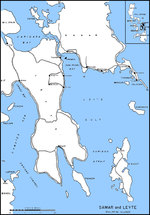 | 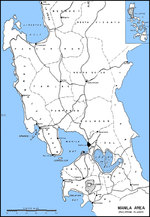 | 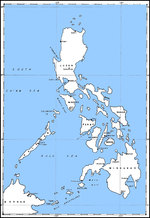 | 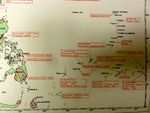 | 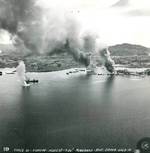 |
| Map of Leyte Gulf, Philippine Islands | Map of Luzon, Philippines from Lingayen Gulf to Manila Bay | Map of the Philippine Islands | Map showing Japanese positions across the southern Pacific, published in US Pacific Fleet and Pacific Ocean Areas Information Bulletin No. 124-44 of 15 Aug 1944 | Strike photo taken from planes flying from USS Essex of the attack on Surigao Harbor in northern Mindanao, Philippine Islands, 9 Sep 1944 |
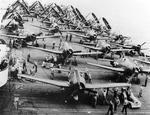 | 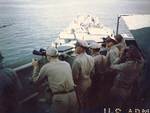 | 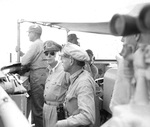 | 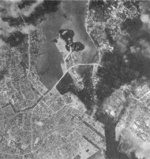 | 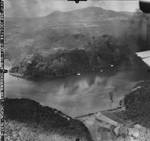 |
| F6F-5 Hellcats being prepared for take-off aboard the carrier Franklin off Luzon, Philippine Islands, Oct 1944. Note SB2C Helldivers spotted aft. | Kenney (center) and MacArthur (right) aboard USS Nashville off Leyte, Philippines, Oct 1944 | United States Army General Douglas MacArthur and his Chief of Staff, Lieutenant General Richard Sutherland, on the flag bridge of USS Nashville during the Leyte landing operations, Oct 1944. | Naha, Okinawa, Japan seen from an American carrier aircraft during the raid of 10 Oct 1944 | Strike photo taken from planes flying from USS Bunker Hill of Japanese Destroyer Escorts after being attacked in Unten Harbor, Okinawa, Japan, 10 Oct 1944 |
See all photos of Philippines Campaign, Phase 1, the Leyte Campaign on WW2DB
Return to Pacific War Maps Page
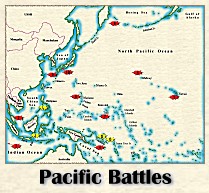
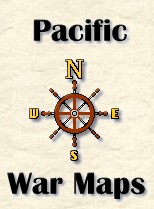




 = Battle
= Battle x2
x2 x2
x2 x10
x10 x2
x2 x15
x15 x2
x2
 x2 sunk (Maya, Atago )
x2 sunk (Maya, Atago ) x1 heavily damaged(Takao)
x1 heavily damaged(Takao) x2
x2 x2
x2 x7
x7 x2
x2 x15
x15 x260 (approx.)
x260 (approx.)
 x1 sunk (Musashi)
x1 sunk (Musashi) x1 damaged (Yamato)
x1 damaged (Yamato) x1 damaged (Nagato)
x1 damaged (Nagato) x1 damaged (Tone)
x1 damaged (Tone) x3 damaged (Fujinami, Kiyoshimo, Uranami)
x3 damaged (Fujinami, Kiyoshimo, Uranami) x2
x2 x3
x3 x1
x1 x11
x11 x6
x6 x3
x3 x5
x5 x29
x29 x2 sunk (Fuso, Yamashiro)
x2 sunk (Fuso, Yamashiro) x1 sunk (Mogami)
x1 sunk (Mogami) x1 damaged (Nachi)
x1 damaged (Nachi) x1 damaged (Abukuma)
x1 damaged (Abukuma) x3 sunk (Michishio, Yamagumo, Asagumo)
x3 sunk (Michishio, Yamagumo, Asagumo) x1 damaged (Shigure)
x1 damaged (Shigure)
 x1 damaged (friendly fire)
x1 damaged (friendly fire) x1
x1 x3
x3 x6
x6 x2
x2 x11
x11 x6
x6 x3
x3 x3
x3 x12
x12 x6
x6 x5
x5 x500 (approx.)
x500 (approx.) x3 sunk (Suzuya, Chokai, Chikuma)
x3 sunk (Suzuya, Chokai, Chikuma) x3 damaged (Kumano, Haguro, Tone)
x3 damaged (Kumano, Haguro, Tone) x1 sunk (Gambier Bay)
x1 sunk (Gambier Bay) x3 damaged (Kalinin Bay, Fanshaw Bay, White Plains)
x3 damaged (Kalinin Bay, Fanshaw Bay, White Plains) x2 sunk (Johnston, Hoel)
x2 sunk (Johnston, Hoel) x1 damaged (Heerman)
x1 damaged (Heerman) x1 sunk (Samuel B. Roberts)
x1 sunk (Samuel B. Roberts) x2 damaged (Raymond, Dennis)
x2 damaged (Raymond, Dennis) x? destroyed
x? destroyed
 x1
x1 x3
x3 x2
x2 x3
x3 x8
x8 x108
x108
 x9
x9 x8
x8 x6
x6 x4
x4 x9
x9 x57
x57 x1100 (approx.)
x1100 (approx.)
 x1 sunk (Zuikaku)
x1 sunk (Zuikaku) x3 sunk (Chitose, Chiyoda, Zuiho)
x3 sunk (Chitose, Chiyoda, Zuiho) x1 damaged (Ise)
x1 damaged (Ise) x1 sunk (Tama)
x1 sunk (Tama) x1 damaged (Oyodo)
x1 damaged (Oyodo) x2 sunk (Akizuki, Hatsuzuki)
x2 sunk (Akizuki, Hatsuzuki)
 x? destroyed
x? destroyed
 x7
x7 x40 (approx.)
x40 (approx.)
 x350 (approx.)
x350 (approx.)
 x3 sunk (Shimakaze, Naganami, Hamanami, Wakatsuki)
x3 sunk (Shimakaze, Naganami, Hamanami, Wakatsuki) x? destroyed
x? destroyed

